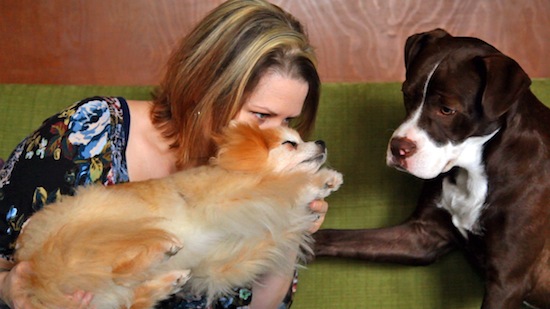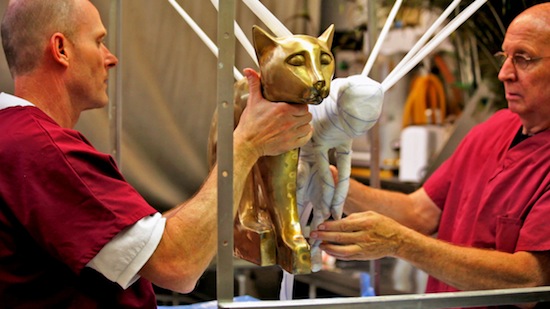
Amy Finkel’s documentary film “FUREVER” is an official selection at the 2013 Brooklyn Film Festival. FUREVER explores the dimensions of grief people experience over the loss of a pet. The film features interviews from grieving pet owners, veterinarians, psychologists, sociologists, religious scholars, neuroscientists, and the many professionals who preserve a pet’s body or re-purpose a pet’s remains in unique ways including taxidermy, cloning, mummification, and freeze-drying. Considering that Amy made a documentary about four-string jazz banjo culture entitled “Zing! Went the Strings of My Heart: The Banjomaniacs of Guthrie,” we wanted to know how did she end up making a documentary about a pet’s last rites.
We connected with Amy at the Brooklyn Film Festivals in her hometown, Brooklyn, New York, with lots of questions and she provided us with lots of answers.
VIMOOZ: First, congratulations on FUREVER being an official selection in the 2013 Brooklyn International Film Festival? How does it feel?
Amy Finkel: Thanks! It’s wonderful! The FUREVER screenings thus far have all been in other faraway cities, so I’d been hoping for a great hometown screening, and this is, of course, it. I was really excited for my friends to get to see the film; many have helped me so much on it over the years. And I just adore all of the people who run the Brooklyn Film Festival, so it’s been fantastic.
VIMOOZ: Am I correct – you are a New Yorker…and live in Brooklyn?
Amy Finkel: I do indeed. In Boerum Hill — the same apartment for 15 years now!

VIMOOZ: Tell us about the film?
Amy Finkel: It’s called FUREVER and it’s a feature-length documentary about pet loss, the dimensions of grief people experience when they lose a pet, the sociological evolution of pets in our culture, and the myriad ways we choose to memorialize our pets when they pass away.
FUREVER features interviews with grieving pet owners, veterinarians, psychologists, sociologists, religious scholars, neuroscientists, and the many professionals who preserve a pet’s body for their devastated clientele, or re-purpose a pet’s cremains in unique ways (taxidermy, cloning, mummification, freeze-drying, and many more), FUREVER confronts contemporary trends, perspectives, and relevant cultural assumptions regarding attachment, religion, ritual, grief, and death, and studies the bonds that form between humans and animals, both psychological and physiological.
VIMOOZ: What was in your opinion, the most outlandish (if I dare use that word) pet memorial you’ve seen while filming the documentary or in general?
Amy Finkel: Hmmm…at this point I’m pretty desensitized to it all. I think dog cloning is the most extreme, because it’s the most expensive ($100,000) and you can only do it in South Korea (fewer animal welfare organizations there). Plus many people who choose that option truly believe they’re cheating death. It’s also the most technologically advanced. But it’s funny to me what people think of as extreme. I did an interview with someone in the film who freeze-dried his pet, and he finds the idea of having a pet’s ashes on a mantelpiece unbelievably distasteful. As far as actual physical memorials go, for me, the most outlandish were always those that were the most kitsch. I adored one that was an elaborate silver memorial of a dog urinating on a fire hydrant. While it wasn’t working when we were there, after speaking with the pet cemetery where I found it, they said it’s usually a working fountain.
VIMOOZ: How did you come up with the idea for FUREVER?
Amy Finkel: We had many types of animals growing up and I became very attached to them over the years. My parents were huge advocates of animal rescue, so we ended up with all sorts: anoles, rats, dogs, budgies, gerbils, etc. And no matter what the species, I found that I became unbelievably attached to each of them. As a result, I had a very tough time letting go. So when I read the article about people freeze-drying their pets several years ago, I was fascinated by what it was about keeping the body of a dead animal in a lively-looking state that was offering so much comfort to the devastated pet owners. How was it not a constant reminder that their pet was gone? Where did they think the soul had gone, if they believed in that (which I suspected they did)? That was not a discussion in my atheist household growing up. But—and I should mention that I’m not particularly judgmental in general—I never assumed they were crazy, as many do. I totally understood their level of attachment and their inability to let go; I simply didn’t understand why it would offer them comfort. I thought it was peculiar, and potentially destructive psychologically if there were a disconnect there (feeling as though their pet was still alive), but I tried to go into it with an open mind. Freeze-drying certainly would not have offered comfort to me. But I’d often wondered why I was getting so attached to my animals; whether it was projection or perhaps being less tolerant of humans than animals (I did have a lot of human friends growing up too). I figured there had to be some physiological component, which is why I put a whole segment in the film about the biology of the human-animal bond. But yes, for some reason freeze-drying was the perfect jumping off point for an inquiry of all of these questions, and an exploration of grief in general, so I set off to investigate.
VIMOOZ: Are you a pet owner? If yes, what pets do you own? If not, why not?
Amy Finkel: I’m afraid that my (rent-controlled) apartment doesn’t allow pets, so I don’t have one. But I’m huge animal lover. If I could have a dog now, I would in a heartbeat. Luckily, I have numerous surrogate dogs in the neighborhood, so I do get my fix here and there.
That said, I do, actually, have some freeze-dried and taxidermied animals: Chompers, my groundhog, Fleischesser, my armadillo, and angel, my wild boar. One of my subjects, Mac, gave them to me as thank you gifts for making his website. I feel a bit uneasy knowing that they, likely, did not die of natural causes, nor, unlike the boar, did anyone eat their meat, so it makes me feel better to treat them in death with the dignity and respect they never received in life. They get frequent positive affirmations and simulated food offerings. You know, for that extra dose of anthropomorphic affection (with a chaser of projection). Chompers and Angel spend time with me in my living room, and Fleischesser lives in my office, positioned so that he may stare in perpetuity at a gorgeous old mannequin whose arms frequently fall off, as an homage to his species’ leprotic leanings.

VIMOOZ: Would you/have you ever created a pet memorial? Would you consider it?
Amy Finkel: We always buried our small animals in the backyard or cremated our larger ones (I keep their ashes now). At this point, I’ve of course, seen all that can be done with a deceased pet. Most of the memorials would be cost prohibitive for me and wouldn’t offer me much comfort, but I love Jessica Joslin’s articulated skeleton work (not sure I’d be able to do that with a pet, but I do think her work is beautiful). I can absolutely imagine pressing the ashes of a pet into a vinyl record (“And Vinyly”). I love that option. I love a lot of the options — I vetted all of the businesses in the film; all of the company owners are really great people who mean well and are by no means simply trying to exploit pet owners at a time when they’re most vulnerable.
VIMOOZ: What do you want viewers to take away from watching the documentary?
Amy Finkel: I’m hoping that the stigma attached to grieving the loss of a pet can be removed.
VIMOOZ: By the way who came up with the name for the film?
Amy Finkel: My friend, Laura Pence! I told her that I wanted to call it “Forever” (I’m pretty sure we were pretty tipsy at the time), and she cracked up and said, “FUR-ever!” She thought she was making a joke, but I knew immediately that there was no other title but that.
VIMOOZ: What’s next for Furever?
Amy Finkel: We’re currently working out our distribution plans — check the fureverfilm.com website in the next few weeks for details about that. And we’re doing the film festival route for the next year (we started two months ago).

Leave a Reply
You must be logged in to post a comment.